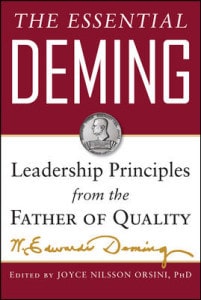 I've really enjoyed reading the book The Essential Deming: Leadership Principles from the Father of Quality
I've really enjoyed reading the book The Essential Deming: Leadership Principles from the Father of Quality that was published last year. I think this link will work… you can view my my public Kindle notes and profile online.
If you haven't read Dr. Deming's work, my suggestions are to start with either Deming's own Out of the Crisis. Or, I also recommend a book written about Dr. Deming and his philosophy, Dr. Deming: The American who Taught the Japanese About Quality.
Dr. Deming was incredibly influential on Toyota and other Japanese companies… and you can see the roots in what Deming said and taught about continuous improvement — as documented in The Essential Deming.
Some quotes from Deming and my thoughts…
“Workers in Japan always had the privilege not only of making suggestions, but of trying them out.”
That's a key principle of Kaizen — that employees don't just make suggestions, but they also get to participate in the full Plan-Do-Study-Adjust (PDSA) cycle, which includes understanding the problem, testing countermeasures, and evaluating the results. The role of workers goes far beyond just dropping a slip of paper into a suggestion box. Employees should work together with each other and with managers to make improvement happen.
In this article, Deming states that if companies try to start their improvement efforts with “QC-Circles,” it will delay improvement:
Moreover, little contribution from QC-Circles is possible except where the management is ready to act on recommendations of a Circle. The fact is that, in America, management is not ready
QC-Circles are the last step, not the first step, in improvement of quality and productivity.
The first step is therefore good management. QC-Circles will follow naturally after good management is established.
Dr. Deming is right in cautioning us that senior leaders are responsible for creating the tone and establishing a culture in which employees can identify problems (without fear of retaliation) and participate in the actual improvement work. That's why Joe Swartz and I have focused so much on the role of leaders.
Deming also said:
“Anytime you say something, people will give you ten reasons why you can't do it. What I want to hear is the one reason you're going to do it.”
That reminds me of the old Henry Ford-ism:
“Whether you think you can, or you think you can't–you're right.”
We need to be positive and figure out HOW to solve problems rather than making excuses about why we can't.
Deming also talked about the power of intrinsic motivation, pride, and joy:
What is at the heart of the transformation? It is the release of the power of intrinsic motivation. How? By creating joy, pride, happiness in work; joy and pride in learning.
One is born with a natural inclination to learn and to be innovative. One inherits a right to enjoy his work. Psychology helps us to nurture and preserve these positive innate attributes of people.
Listen to my podcast with Rich Sheridan, where he talks about joy in the workplace.
Deming warned against relying too much on extrinsic incentives (as has Daniel Pink, more recently):
The result of reward under these conditions is to throttle repetition: he will lose interest in such pursuits. Monetary reward under such conditions is a way out for managers that do not understand how to manage intrinsic motivation.
Wise words, as always, from Dr. Deming. How can you apply them in your workplace and in your Lean or Kaizen efforts?
Please scroll down (or click) to post a comment. Connect with me on LinkedIn.
Let’s work together to build a culture of continuous improvement and psychological safety. If you're a leader looking to create lasting change—not just projects—I help organizations:
- Engage people at all levels in sustainable improvement
- Shift from fear of mistakes to learning from them
- Apply Lean thinking in practical, people-centered ways
Interested in coaching or a keynote talk? Let’s start a conversation.









![When Was the Last Time a Leader Around You Admitted They Were Wrong? [Poll]](https://www.leanblog.org/wp-content/uploads/2025/07/Lean-Blog-Post-Cover-Image-2025-07-01T212509.843-100x75.jpg)
Mark,
Great article! I would like to add that the data should tell you what the problems are . You should have a tool in your Continuous Improvement system which captures this data by magnitude so your efforts are focused on those issues that will have the greatest impact . Thanks for the article. .
Rafael
As for as excuses, the one trick I have learned is to ask the resistance to be rephrased from “that won’t work because . . . ” to “that would only work if . . . “. It’s essentially the same statement, but the latter highlights the problems – generally few and simple – that must be addressed to turn the improvement into a reality.
Great article, Mark!
Yes, that’s the difference between excuses (which are things that make you stop) and barriers (things that you can work through).
Sometimes, there are legitimate reasons why something can’t be done or shouldn’t be done. I don’t think Dr. Deming would want us to steamroll over people in the name of being positive and moving forward… we should listen to and respect the concerns of others while not making a lot of excuses ourselves.
Great article! Thanks for posting Mark.
I have a question concerning the challenge of time allocation for improvement activity. My company has been striving to continuously improve our processes for many years. The issue is always, “How do we balance improvement time with making shipments?” We want to get our employees involved, but it keeps coming back to this issue.
Does anyone have any practical suggestions on how to free employees up to work on improvements?
Thanks for any advice you have to give!
Hi Nick – see this post.
Yes, you have to make today’s shipments. At first, you might need to schedule overtime to work on improvement — treating that not as a cost, but as an investment in the future. Then, you can free up time that allows you to do Kaizen on a daily basis.
Or, as a starting point… if everybody is 100% busy all of the time, that should be reconsidered. When everyone is 100%, that leads to really poor flow and really long waiting times. A better-designed system has slack to help absorb variation and one thing you can do with that slack time is Kaizen.
See the book “Slack” for more on this.
Mark, great article, as usual. I particularly valued the comment from Deming on QC-Circles. In long-term care, there is actually research that shows quality improvement initiatives (specifically, culture change implementations) do better when the nursing home administrator is involved and committed, but not actually responsible for authorizing individual improvement activities (having delegated actual authority to local teams). It’s a huge challenge to overcome in an industry driven to improve primarily through regulatory sanctions or quarterly quality assurance committees.